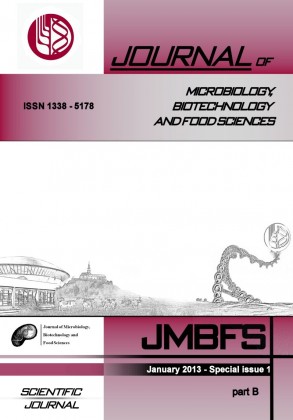DIFFERENTIATION OF BARLEY GENOTYPES BASED ON DNA POLYMORPHISM
Keywords:
barley, DNA polymorphism, DNA markers, microsatellite, genetic diversityAbstract
Identification and characterization of genotypes is essential for improving the quality of cultivated varieties in breeding programs. Information about the origin of varieties can help farmers in selecting appropriate varieties to specific growing conditions or end use of crops. A set of ten microsatellite markers was used to describe genetic diversity in a sample of 30 barley (Hordeum vulgare L.) genotypes. A total of 55 different alleles were amplified using ten SSR markers localized on chromosomes 1H, 2H, 3H, 5H, 6H, 7H with an average number of 5.5 alleles per locus. On the basis of allele frequencies we have calculated diversity index, polymorphic information content and index of probability, which have mean values of 0.664; 0.643 and 0.126 respectively. These values indicate high differentiation ability of SSR markers. In the created dendrogram using hierarchical cluster analysis using UPGMA algorithm we were able to differentiate all 30 barley genotypes. The results show that DNA markers are suitable for the identification and differentiation of genotypes and indicated the effectiveness of microsatellite markers to describe genetic diversity.Downloads
Download data is not yet available.
Downloads
Published
2013-02-01
How to Cite
Tomka, M., Chňapek, M., Balážová, ŽelmÃÂra, & Gálová, Z. (2013). DIFFERENTIATION OF BARLEY GENOTYPES BASED ON DNA POLYMORPHISM. Journal of Microbiology, Biotechnology and Food Sciences, 2(special issue 1), 1677–1684. Retrieved from https://office2.jmbfs.org/index.php/JMBFS/article/view/7262
Issue
Section
Biotechnology
License
Copyright (c) 2013 Marián Tomka, Milan Chňapek, ŽelmÃÂra Balážová, Zdenka Gálová

This work is licensed under a Creative Commons Attribution 4.0 International License.
All papers published in the Journal of Microbiology, Biotechnology and Food Sciences are published under a CC-BY licence (CC-BY 4.0). Published materials can be shared (copy and redistribute the material in any medium or format) and adapted (remix, transform, and build upon the material for any purpose, even commercially) with specifying the author(s).

